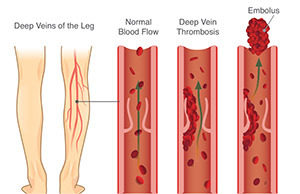Your risk of blood clots in the hospital

While you are in the hospital, you are not as active as you normally are. The lack of activity, along with being sick or having surgery, puts you at risk of getting a blood clot inside a vein. Clots block blood flow (either partially or completely).
Deep vein thrombosis (DVT) is a common type of blood clot that usually forms in the leg. It can cause blood to pool in your legs, which leads to swelling, changes in skin color and pain.
Pieces of the clot can break off and travel to the lungs (embolize). This is called a pulmonary embolism (PE), which can be life-threatening. Deep vein thrombosis and PE, together, are known as venous thromboembolism (VTE). You will likely hear your doctor and nurses talk about blood clots as VTEs or DVTs.
How can I help prevent a blood clot?
Venous thromboembolism is one of the most common and preventable causes of hospital death after surgery. Walking, compression stockings and special devices to increase leg circulation are a few ways to help reduce your risk of developing a blood clot. But, one of the most important ways to reduce your risk in the hospital is the use of anticoagulant medications (blood thinnersK). This type of medication keeps blood from clotting like it normally does. It does not dissolve blood clots, but it does keep clots from forming.
Heparin and Lovenox (enoxaparin) are low-dose anticoagulant medications that help prevent blood clots. Your doctor has ordered one of these medications for you. It is very important that you take this medication as prescribed.
Your doctor may also have you take other blood-thinning medications, such as rivaroxaban (Xarelto), apixaban (Eliquis) or fondaparinux (Arixtra).
How do I take heparin or enoxaparin (Lovenox)?
Heparin and enoxaparin (Lovenox) are given by a shot (injection). The injection is usually given in the belly or upper arm. The injection may be uncomfortable, but the discomfort lasts only a few seconds and can save your life. These areas are the least painful spots to get the medication. It is common to get bruises in the areas where the shots are given.
What are the possible side effects of the medication?
Tell your nurse or other member of your healthcare team right away if you have signs of a severe allergic reaction:
- Trouble breathing.
- Swelling of your face, lips, tongue or throat.
- Feeling like you are going to pass out.
Less serious side effects are:
- Nausea.
- Vomiting.
- Sweating.
- Hives.
- Itching.
Because the medication thins the blood, you may notice that you bleed more easily while taking it and for several weeks after you stop taking the medication.
How long will I need to take this medication?
Your doctor will let you know how long you need to take your anticoagulant medication. You may be able to take a different type of medication after you leave the hospital.
It is important to follow your doctor’s orders to prevent a blood clot. If you have any questions, please ask your doctor or nurse.
Learning Check: Can you answer these questions?
- Why are you at-risk for a blood clot?
- How can a blood clot be prevented?
- What are heparin and enoxaparin (Lovenox)?
- What are symptoms of a severe reaction to the medications?